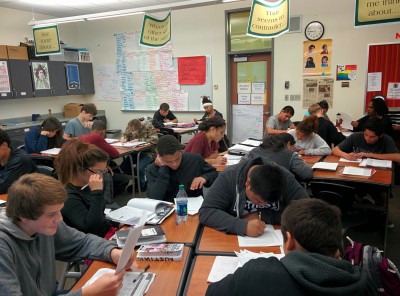By Tom White
Counting my parents, I was the fourth person in my family of seven to go to college. That was because I was the second-oldest kid. My three younger siblings also went to college. We were raised on going to college. When I found a five dollar bill in a birthday card from a grandma or uncle, I was allowed to hold it for a few days and then it was taken away and put into my savings account where it was “saved for college.”
In my life, college was a huge part of the eighteen years that preceded it.
That, however, is not the case for many kids in America. A recent study by the National Student Clearinghouse Research Center shows a huge disparity in college attendance between students in “high income schools” and “low income schools.”
As educators, we play a long game. Our job is to take five year olds and turn them into college-ready adults. Thirteen years later. So why is it that that the relative income level of a student’s family and classmates should play such an important role in that student’s likelihood of becoming ready for college?
I don’t think anyone has the complete answer. But I keep thinking back to my own childhood, growing up with college-educated parents and the expectation that I was also going to college. Not to mention the fact that they were prepared to help me pay for it and had the wherewithal to get me through the process of enrolling. With that kind of support, there was about a 99% chance that I was going to college. But I honestly think if you removed those factors from my personal equation, the number would be close to 50%. I could have gone either way.
I teach fourth grade. Most of my students don’t really understand what college is all about. Some of them, however, know that it’s the pathway to an adult life with more choices, more opportunities, and yes, more money. Not surprisingly, most of those kids come from families where the parents went to college. I think the biggest challenge in our state is to include the rest of those students in this culture of college readiness. We need to make college students out of every five year old, not just the lucky ones. But how?
There are probably lots of effective ways to make college students out of little kids, but one that I’m fairly familiar with is AVID. It stands for Advancement Via Individual Determination. AVID essentially does what my parents did for me. It creates an expectation that each kid is heading toward college. It focuses on creating a growth mind-set and instilling the foundational skills that college-bound kids need. It also works with parents, teaching them how to get their kids into – and through – college.
But it’s also expensive. It involves teacher training, tutoring and on-site coordination. AVID, or any intensive support program designed to close the college-readiness gap between students from high income schools and those from low income schools costs a lot of money. A lot of districts just can’t afford it. They shouldn’t have to. The state should.
As far as I’m concerned, an intensive, targeted, college-readiness initiative would deliver a bigger bang for the buck than reducing class size. That’s not to say that I oppose reduced class size. I have 28 kids in my class right now, and I know that I would be a better teacher if there were only 25. But I’m not sure losing those three kids is going to make the difference in terms of getting the other 25 into college.
And getting kids into college is what we’re paid to do.



 han a confusing five-way stop. Everyone yields and everyone turns right. It’s consistent and predictable.
han a confusing five-way stop. Everyone yields and everyone turns right. It’s consistent and predictable.
